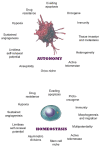Cancer: a "stem-cell" disease?
- PMID: 23647946
- PMCID: PMC3651409
- DOI: 10.1186/1475-2867-13-40
Cancer: a "stem-cell" disease?
Abstract
Background: Nowadays, we believe that cancer is a genetic disease. We focus on the genetic targets and epigenetic changes in a tumor. Remarkably, many crucial signal pathways in a malignant cell involve "stem-ness" genes. The prevalence of stem-ness in cancer suggests that cancer has a stem-cell origin and is a stem-cell disease.
Presentation of the hypothesis: The observation that many innate stem-ness properties are easily interchangeable with malignant hallmarks needs to be further elucidated. There appears to be a malignant potential in every stem cell and a stem cell potential in every malignant cell. I hypothesize that cancer is a stem-cell disease rather than a genetic disease.
Testing the hypothesis: We will use homeobox genes to endow a certain progenitor cell with specific stem-ness properties and confer different stem-cell phenotypes to the particular cell type in a hierarchical manner. We will demonstrate that an earlier homeobox gene plus a genetic defect (such as Pten loss) tend to form a more virulent tumor, while a later homeobox gene plus the same genetic defect tend to express a more indolent phenotype. Importantly, we will show that in clinically relevant cancer subtypes, those with worse clinical outcomes may paradoxically harbor fewer genetic mutations than those with better outcomes do.
Implications of the hypothesis: The recognition that cancer is a stem-cell disease will instigate major paradigm shifts in our basic understanding of cancer. Many fundamental principles of oncology, such as multistep carcinogenesis, need to be reconciled. The realization that cancer is a stem-cell disease will also have profound clinical implications on personalized care. Many aspects of our current clinical trials need to be reevaluated.
Figures
Similar articles
-
Stem Cell Origin of Cancer: Implications of Oncogenesis Recapitulating Embryogenesis in Cancer Care.Cancers (Basel). 2023 Apr 27;15(9):2516. doi: 10.3390/cancers15092516. Cancers (Basel). 2023. PMID: 37173982 Free PMC article.
-
Stem Cell Theory of Cancer: Origin of Tumor Heterogeneity and Plasticity.Cancers (Basel). 2021 Aug 9;13(16):4006. doi: 10.3390/cancers13164006. Cancers (Basel). 2021. PMID: 34439162 Free PMC article.
-
Stem Cell Theory of Cancer: Origin of Metastasis and Sub-clonality.Semin Diagn Pathol. 2023 Jan;40(1):63-68. doi: 10.1053/j.semdp.2022.06.012. Epub 2022 Jun 15. Semin Diagn Pathol. 2023. PMID: 35729019 Review.
-
HOXC8 regulates self-renewal, differentiation and transformation of breast cancer stem cells.Mol Cancer. 2017 Feb 16;16(1):38. doi: 10.1186/s12943-017-0605-z. Mol Cancer. 2017. PMID: 28202042 Free PMC article.
-
Genetic pathways of two types of gastric cancer.IARC Sci Publ. 2004;(157):327-49. IARC Sci Publ. 2004. PMID: 15055305 Review.
Cited by
-
Diverse cellular players orchestrate regeneration after wounding.Exp Dermatol. 2021 Apr;30(4):605-612. doi: 10.1111/exd.14248. Epub 2020 Dec 8. Exp Dermatol. 2021. PMID: 33251597 Free PMC article.
-
Intratumoral heterogeneity: Role of differentiation in a potentially lethal phenotype of testicular cancer.Cancer. 2016 Jun 15;122(12):1836-43. doi: 10.1002/cncr.29996. Epub 2016 Mar 28. Cancer. 2016. PMID: 27018785 Free PMC article.
-
Tissue elasticity regulated tumor gene expression: implication for diagnostic biomarkers of primitive neuroectodermal tumor.PLoS One. 2015 Mar 16;10(3):e0120336. doi: 10.1371/journal.pone.0120336. eCollection 2015. PLoS One. 2015. PMID: 25774514 Free PMC article.
-
Periostin is a new potential prognostic biomarker for glioma.Tumour Biol. 2014 Jun;35(6):5877-83. doi: 10.1007/s13277-014-1778-3. Epub 2014 Apr 10. Tumour Biol. 2014. PMID: 24719188
-
The scientific method: pillar and pitfall of cancer research.Cancer Med. 2014 Aug;3(4):1035-7. doi: 10.1002/cam4.248. Epub 2014 Apr 8. Cancer Med. 2014. PMID: 24711219 Free PMC article. No abstract available.
References
-
- Tu S-M. In: Cancer treatment and research; vol. 154. Rosen ST, editor. New York: Springer; 2010. Origin of cancers. Clinical perspectives and implications of a stem-cell theory of cancer. - PubMed
-
- Virchow R. In: From demons and evil spirits to cancer genes. Fitzgerald PJ, editor. Washington DC: American Registry of Pathology; 2000. Die krankhaften geschwulste [in German]. 3 vols. Berlin: a hirschwald, 1863–1865.
LinkOut - more resources
Full Text Sources
Other Literature Sources
Research Materials


